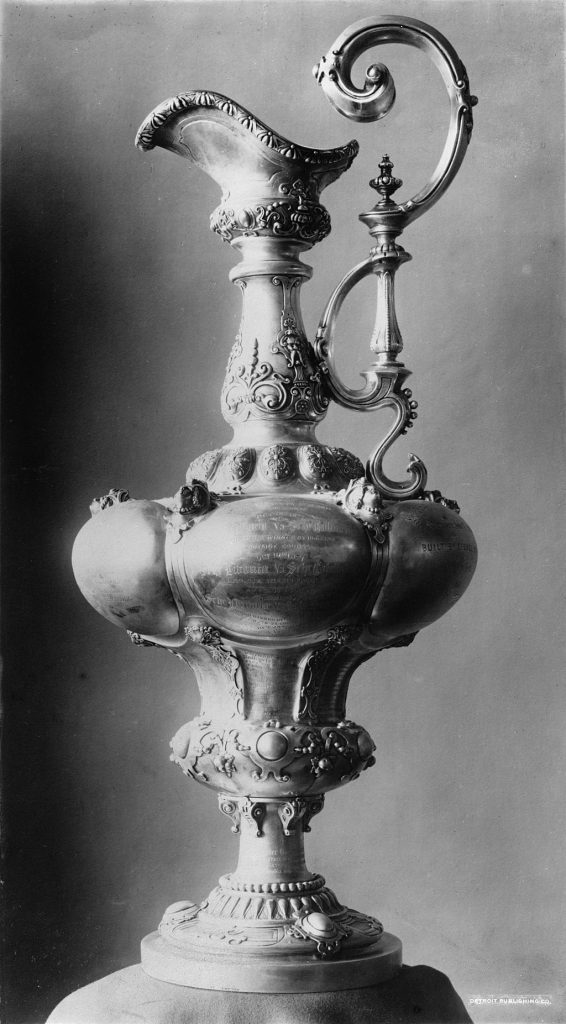Sports and contests are common interests all around the world. One of the most popular and oldest sporting events today is the Olympics. The Olympics are based on skill and physique and generate publicity all over the world. Similar to the Olympics and other world contests, there’s a more obscure sport most Americans are less familiar with, which is ironically called America’s Cup. Despite being overshadowed by other popular sporting events, such as football or basketball, yacht racing has been around long before the modern Olympics. The America’s Cup dates back to 1851 and was named after the winning schooner boat, America, which was the entry of the New York Yacht Club. Similar to the origin of many sports, sailing was most commonly practiced among the elite groups, but after America’s Cup, yacht and sailboat racing became nationally celebrated. While the cup alone was just a fancy trophy, it embodied a sense of history and prestige and was fiercely sought after. Unlike most competitions, the race was only held when a challenger came forward. This caused only 24 races to take place within 132 years. Over time, the number of challengers grew, and challenger trials were implemented. For 132 years, the New York Yacht Club held the prized cup and remained its undisputed champion. However, the beginning of the 25th challenger trials marked the end of this uncontested reign.1

Newport Harbor, summer of 1983, the winds were blowing, and the water was filled with boats, all there for a singular purpose. These were the trial races that determined the foreign challenger, the challenger who would go on to compete in the best of seven finals against the defendant of the cup, the New York Yacht Club. The New York Yacht Club has already done its own trials, intent to find the best boat design to defend the cup. The winning boat, Liberty, looked like she would have no problem defending the title in Newport. However, the Royal Perth Yacht Club’s challenger boat, Australia II, had a trick up her sleeve.2
The Royal Perth Yacht Club contended for the cup for many years. In the 1980 race, they had a boat with a very flexible mast that allowed the boat to occasionally carry a larger mainsail and go much faster than normal in lighter winds. However, this design was not enough of an advantage for them, as they lost the match to New York Yacht Club’s Freedom, skippered by Dennis Conner, who proved that better sailing techniques are better than speed. Three years later, Conner was still the skipper of the new boat Liberty. Undaunted, the Australians were not ready to give up, and they worked together with designers and architects to create a beautiful design that they believed would sail them to victory.3

Ben Lexcen and a team of Dutch engineers designed a winged keel that allowed Australia II to demolish the competition during the trial rounds for the Challenger spot.4 The design was in a bomb shape with fins that gave it a deeper draft when heeled over and made the design perfect for gliding through the water and crossing the winds to tack. The immense success of the keel stirred such a controversy that the American team became suspicious, and tried to have Australia II eliminated from the race. The Americans protested that the keel design made the boat exceed the 12-meter rating. If this was accepted, the Australians would have to reduce other dimensions to compensate.5 Despite the protests of the Americans, the International Yacht Racing Union committee deemed the design legal and Australia II was able to continue on to the semifinals and finals. As the controversy escalated, the New York Yacht Club continued to seek avenues to question Australia II’s eligibility to race and even tried to purchase the keel design. They were unsuccessful, and Australia II, having finally defeated all the other foreign opponents, was deemed the challenger.6
The challenger races, best out of seven, began on September 14, 1983. Liberty won the first race, but that was only the first out of seven. Before the second race even began, Australia II suffered a break in its mainsail at the masthead; the big sail could not be drawn properly. Despite this blow, Australia II was in the lead and was flying past Liberty for more than half of the race, but as she came around the fourth leg of the six-leg race, Liberty came from behind! Liberty began a tacking duel and the two boats fought by crossing the wind sixteen times. Australia II was following suit until the final tack where the crew was unable to control the sail and Liberty flew by and claimed the second win. The score was a dreadful 2-0, but the Australian team was not ready to give up. Many spectators and reporters began to doubt the possibility of Australia II winning the cup after all. They managed to win one race, bringing the score to 2-1, before all hell broke loose. Luck was not on their side, evident by the race being canceled due to insufficient windspeeds every time Australia II was taking the lead in the race. On top of the faltering wind speeds, there were breakdowns galore! On the day the winds decided to cooperate, the steering pulley gave way about three-fourths into the race. The universe seemed to be rooting for the American team.7 The Australians took a lay day to look over the boat and fix any problems. Then God seemed to smile down on them because the next two races were astounding victories by the Australians.
Finally, the score was tied at 3-3. The spectators and fans of both teams were on the edge of their seats. This America’s Cup race was one of the most intense races in sailing history. The two boats seemed to be almost equal in sailing ability, unlike when America won the first-ever America’s Cup race by an astounding eighteen-minute lead. The suspense was palpable the week before the seventh and final race. Both teams took lay days to convene, look over their boats, and make sure their victory was guaranteed. Hundreds of flag-waving, horn-blowing supporters gathered at the dockside in the morning. But to everyone’s dismay, the race was called once again due to shifty wind patterns. The frustration was causing a rupture in excitement for the results of the final race. On top of the crowd’s disappointment, both of the teams were getting quite irritated and they began accusing each other of foul play. After a small investigation on both teams, it was concluded that there was no evidence for these claims, and they were ignored for the most part. It was an excruciating wait, but finally, on the morning of September 26, 1983, the race was about to begin.8
The winds were at about eight knots, a light but acceptable speed. Both teams seemed hesitant at the pre-start of the match. This was to be the last race, but more importantly, the deciding race. This race would crown the winner of the Cup, either the victory streak of the New York Yacht Club would continue or there would be a new holder of the trophy, the Australians. The race began, and by sight, Liberty won the start by eight seconds. However, the speed and smooth sailing of the Australians gave them a controlling position at the favored end sailing toward the favored side, which gave them the early lead. Around the fourth leg of the race, Liberty was in the lead by 57 seconds. Onlookers thought the race was already over, but Australia II was not giving up. Liberty failed to cover Australia II, which allowed them to run deeper and faster, assisted by breeze and wind shifts, allowing Australia II to overtake the Americans by the leeward mark. The two boats then engaged in a spectacular tacking duel with nearly 50 tacks, including a number of faked “dummy” tacks trying to break the Australians’ cover. Australia II held on until both boats reached the starboard lay line where she found a wind shift and soon the American lead—and the America’s Cup—was gone with it. Australia II tacked several boat lengths past Liberty at the last moment and stole the victory by an astonishing 41 seconds. With this feat of sailing, the 132 years of U.S. supremacy were finally over.9

The crowds were cheering so loudly, celebrating the Australian triumph. After the cup was handed off to the Royal Perth Yacht Club, it signified the second-ever success by the challenger boat. Ben Lexcen and the skipper of Australia II jumped up and cheered along with most of Australia. America’s Cup was a niche interest within the elite members of society in Australia, but this victory brought many new fans to the sport. The Australians affectionately referred to the cup as the Auld Mug, but the name never stuck. Of course, now the Cup would be up for grabs again and the 26th challenge was already being planned out, but this time the defender was the Australians. The cycle would continue in a few years, but now in the waters of Western Australia. This victory cemented the Royal Perth Yacht Club in sailing history and brought about a new culture within Australia as a whole. Even the Americans, led by Liberty’s skipper, were celebrating, who proclaimed that he was glad that they lost. At the Royal Perth Yacht Club, the Australian prime minister, Bob Hawke, celebrated with other club members with champagne and exchanged friendly telegrams with American president Ronald Reagan.10 The camaraderie was thick, and everyone was celebrating this feat of sailing and sports history. So in the end, the mighty defender of the cup, America, keeled over. This successful defeat has impacted sports history to this day and finally gave a new defender of the America’s Cup, or as the Aussies like to call it the Auld Mug, after the over-a-century long win streak.11
- “History of the America’s Cup,” last modified 2019, https://www.americascup.com/en/history. ↵
- Tony Chamberlain, “Australia II has U.S. worried about losing America’s Cup,” Dallas Morning News, August 14, 1983. ↵
- Karl Burkhardt, “America’s Cup could keel over,” Plain Dealer, August 14, 1983. ↵
- Bruce Stannard, Ben Lexcen: the man, the keel, and the cup (London Boston: Faber and Faber, 1984), 70-71. ↵
- Angus Phillip, “America’s Cup faces own ‘pine-tar’ incident,” The Washington Post, August 10, 1983. ↵
- Associated Press, “Australia II’s keel is legal for Cup race,” Trenton Evening Times, August 11, 1983. ↵
- Angus Phillip, “America’s Cup still waiting for a healthy contest,” Seattle Daily Times, September 16, 1983. ↵
- Associated Press, “America’s Cup showdown postponed,” Trenton Evening Times, September 25, 1983. ↵
- Joanne Fisherman, “Australia II’s victory gone with the wind,” New York Times, September 18, 1983. ↵
- Dick Brinster, “America’s Cup is going ‘down under’,” AP Sports, September 27, 1983. ↵
- Eileen Westley, America’s Cup ’83, the Complete Story (Australia: John Fairfax Marketing, 1983), 100-128. ↵




19 comments
Sherisa Orozco
This was an interesting article. I had no idea of what America’s Cup was. I enjoyed reading this article and it was very detailed. It was exciting to see the way the sport sailing came today to be here in America. Definitely will look into it more in the sport. It was a very well-written article. It was a topic I didn’t have much knowledge of.
Adam Alviar
I didn’t know a single thing, or that The Americas cup even existed, as no seems to talk about it nowadays. It was great to see the passion they had within them and how much they strived to protect the Americas cup as if it were their whole world. It also has to be so scary and challenging with the immense pressure of a 132 year streak of winning. It was great to see the good and fun of sportsmanship at the end of the competition.
Margaret Cavazos
The author of this article provided a very informative article on America’s cup, their passion was evident in the article which was, in turn, an interesting read. I liked the suspense in the article. Even though the outcome is in the title, the author definitely kept the audience on their toes. I find it incredible that this engineering design was enough to compete with the club that had held the cup for 132 years! Even with the design, it seems their win was by a smaller margin that would have been expected.
Addie Piatz
This was a very informative article. I knew absolutely nothing about America’s Cup before reading this but I think its really interesting. The fact that people can find a way to make a competition out of anything truly fascinates me, I never in a million years would have thought about racing boats but the people back in 1983 shined a light on a sport ahead of its time.
Sebastian Azcui
This article is really well written with a lot of information and information I had no idea about before. I never heard about this sport and that it has the America’s cup. I learned a lot about this sport and how this cup is around for so much time. Sailing sports might have been even longer than the Olympics are around. I will find out more about this sport!
Courtney Pena
I have never heard of the America’s Cup as well as yacht racing even though it has been around longer than the Olympics. This article was interesting to read and it educated me on the races. I thought that it was nice how in the end, everyone was celebrating sailing and sports history even though the Americans lost the race.
Vania Gonzalez
This was an interesting article, I had never heard of America’s Cup but it seems like a very interesting yet exciting competition it is very underrated I mean who doesn’t like watching boats sail. Like all sporting events the tension builds as you get closer to finally claiming victory or defeat so it only makes sense they started to accuse each other of foul play as soon as things were not going right for them. In the end the better boat won and the reigning champions must have been a little mad that day.
Ashley Martinez
Before reading this article I had never even heard of The America’s Cup. This was a very interesting article to read which had great details and provided great factual evidence. I learned a lot about this topic thanks to this well written article. This article allowed the reader to stay engaged with the story and stay wanting to read more. I’m sure this was a very intriguing topic for you to write about since it pertains to your major.
Rinnu Joy
This article is very well written and it was so informative too because I have never heard of such a sporting game, America’s cup.I thank you for making me known about the America’s cup. It was very interesting to read through even though I don’t anything about sailing and it is because we have some idea about it when you talked about it in our committee.
Congratulations for the great work Sabrina!
Briley Perkins
I have never heard of the America’s Cup race before, but it was pretty interesting to me. While everyone was going against the underdog, it was good to see them come on top. I do not know very much about boat racing that much, but the article made it sound a little interesting to me. It was a very well written article.